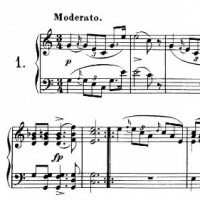A look at Schubert’s Sechs Moments Musicaux, Op. 94, D780
|
Beth Levin [June 2013.]
I: Moderato 3/4 Our lilting introduction: a sweet opening in C major and in unison, as if arrived from nowhere. At measures 4 and 5 the staccato chords transform from major to minor, an aspect of the music that will permeate the work as a whole. Triplets from the first measure find their way into measures 7 and 8, now in the III of C major and build to a powerful broken octave on a B at measure 16. Measure 17 is a full beat’s rest and serves as a suspension of sound that breaks its silence at measure 18. Poignant 2-note slurs – G to E, G to E – emerge from the silent measure, birds in a storm seeking refuge. The performer has to keep the pulse alive in the mute measure so that the ensuing music has the feel of a natural exhale. Measure 30 is heaven in triplets – a luscious spot in G major repeated verbatim but in the minor mode at measure 51. Again, this trait of swapping major for minor, common throughout the work, turns our emotions inside out. One might think of Jane Eyre, ebullient at the altar and the next moment in despair. Measure 67 to the end is an exact repeat of the beginning in this A-B-A form. Repetition in the case of Schubert, a divine plot device, works perfectly to sew up one of the Moments Musicaux. Looking back over the piece, one sees sparse writing, naive, playful triplets and basic chords. But with few notes and the simplicity of a song Schubert delivers wisdom and depth. II: Andantino 9/8 Swaying chords in 9/8 time soothe as if a lullaby. The key of A flat major is warm and the dotted rhythms imbue the melody with a timeless, march-like quality as it propels the melody forward. Suddenly a dramatic schism occurs at measure 18 in both key (F sharp minor) and mood – again, Jane Eyre! By measure 35 we are restored to a harmonious balance, at least for a while. When the contrasting material in F sharp minor, so dark, so painfully sad, reappears at measure 56 we actually feel Schubert’s despair. He magnifies the melody now in accented chords instead of a single note, when one bar earlier we were in a serene aura of A flat major, believing all was well. This place, this crossroads at measure 56, must be timed just right: The juxtaposition of extreme feelings must be handled without a hint of sentimentality or a giving-away of intention before the moment of head-and-heart-spinning trauma. Measure 74 brings back the opening music of the Andantino as once again Schubert ends with a beginning. III: Allegretto moderato 2/4 I know of little so charming as Schubert’s opening oom-pah bass line hinting at the naive dance-like melody to come. Two-note slurs, accented chords and grace notes maintain the simplicity throughout. We are free to imagine Rhineland forests, nymphs, playful imps, daydreams and a cloudless sky. IV: Moderato 2/4 Running 16th notes in C sharp minor flit over a biting bass line in the fourth movement. The patterns of these melodic sixteenths soar and dive, shake and shimmy, and never relent. They begin in piano, to return in forte at measure 31. This changes the emotional color from delicate to ominous. The drive of the sixteenths persists until a fermata at measure 61 signals a stop and transformation. A bucolic tenderness relieves the frenetic opening when a B section is introduced in D flat major. This sense of tension and release allows the music to relax, thus enriching our experience of the movement. Each moment-to-moment is as important as the larger relationship of the Moments Musicaux one to the other. Measure 114 marks the return of the opening material and brings us almost to the end. A coda at measure 175 reminds us fleetingly of the inner section as a sweet memory from one’s past might reappear in a daydream. V: Allegro vivace 2/4 The repetition of a quarter and two eighths forms the main material and its reiteration throughout the work, resulting in a driving, close to nagging force. When the two eighths lead to the following downbeat one perceives a chance for uninterrupted motion of line and rhythm. We come to a delightful contrast to the fiery chords, particularly at measure 33, where a jaunty set of six-bar phrases flit by with poise. Soon, however, a crescendo builds, falls, and builds once again on its way back to the devilish opening chords. VI: Allegretto 3/4 The opening’s long two-note slurs pull at us as much when they are discordant as when they resolve. A flat, that tender key, travels through E major and D flat major, but in the end comes home to A flat. As in the first movement, the writing is spare. A tiny gesture, say a turn of four notes at measure 45, speaks eloquently. A single line conveys great emotion and meaning. After the six movements have been played and we arrive at the final octave on an A flat, we sense a silent consolation, something beyond strife. * * * [ArkivMusic lists 88 options. Schnabel (1937) and Rudolf Serkin (1952) top my preferences; the first is better-known today. I respond to Kovacevich as well, who’s much darker than the norm (on a budget disc with his D. 960). The Lupu and Kempff can be found only via their Schubert boxes. Arrau’s “The Final Sessions” account is very moving but O/P. W.M.]
[More Beth Levin]
[More
Schubert]
[Previous Article:
The IPC Sound Power]
[Next Article:
NMC Ramble]
|
